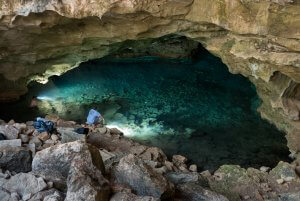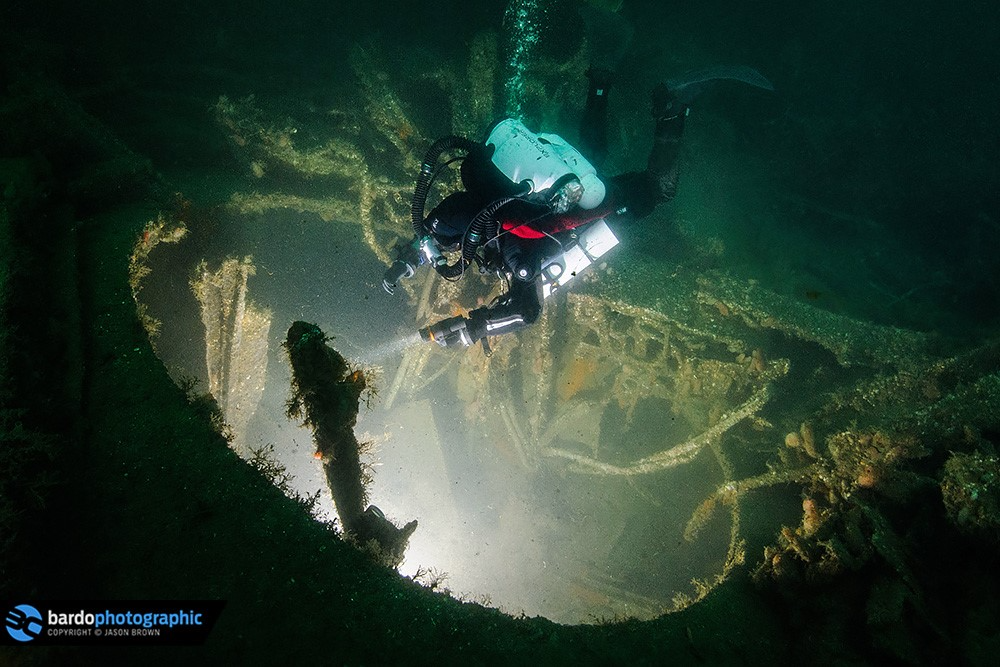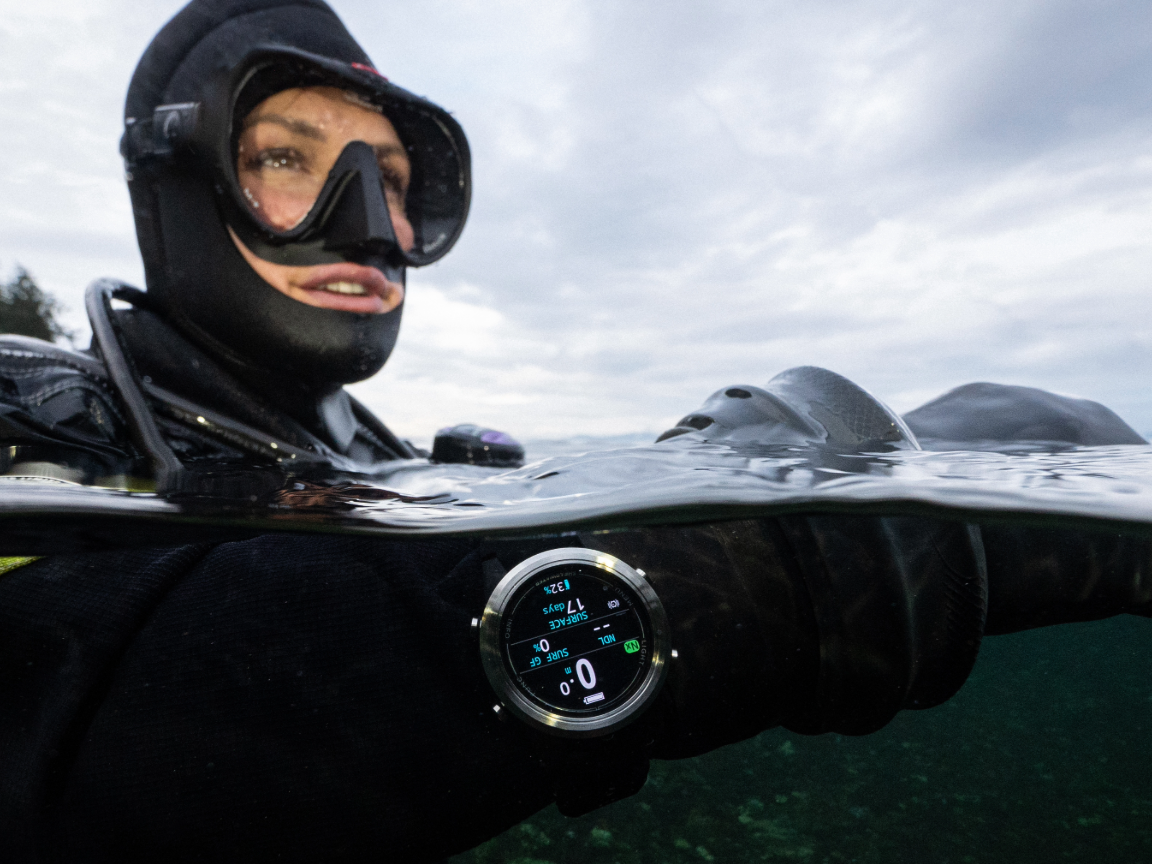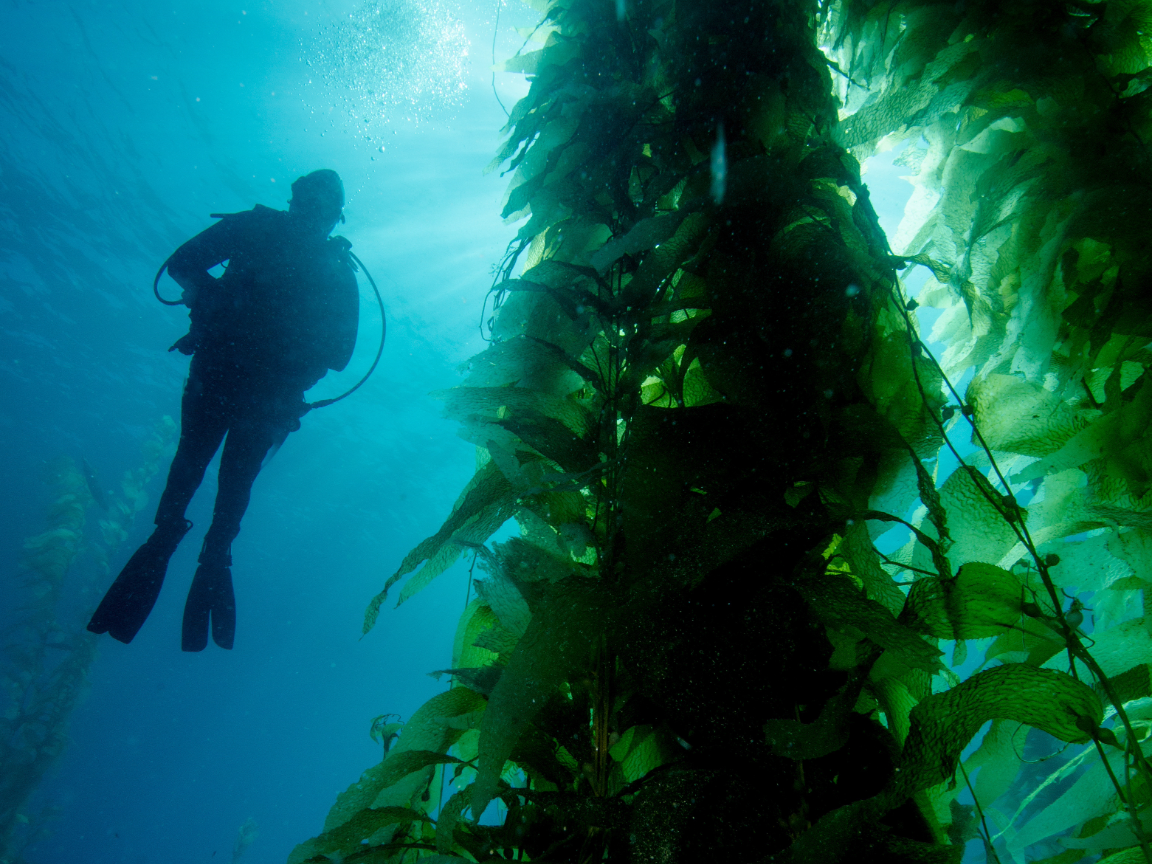
Klukkert and DRSS diver Ramos inspect a bone from an extinct Caribbean sloth in La Jeringa cave. Image credit: Phillip Lehman.
Along the southwest coast of Madagascar, with temperatures in the middle 80s F, June is a relatively cool time of year. Dry, sandy, and rough, the road is lined by great thickets of spiny indigenous succulents and introduced cactus. The destination, a jewel in the Madagascar National Park system called Tsimanampesotse (“tsee-mahn-ahm-pay-sue-tsuh”). Deep into the park we unload the trucks and take to the trail, crossing spans of sand, gravel, and platforms of porous rock with sharp edges that stick like Velcro to soft-soled shoes. Everything is in shades of orange and sage; the occasional baobab tree is glimpsed through breaks in the boulders and bramble. It takes deliberate imagination to disregard the glare of the sun and the chalky red dust on your hands and face, turning your mind’s gaze instead to the forests that must have once covered this land, the oversized lemurs that fed on the trees’ fruits and spread the seeds, and the giant fosa ("foo-suh") that would stalk them as they slept. Still more surreal is that, amid this arid spiny desert terrain, we’ll be heading underwater to study that world.

A critically endangered radiated tortoise (Astrochelys radiata) crossing the sands through the brush in Tsimanampesotse National Park in Madagascar. Image credit: Zachary Klukkert.
I work here with a multinational team of researchers, students, explorers, Madagascar National Park (MNP) staff, and local porters to better understand the paleobiology and extinctions of fauna that once dominated the Tsimanampesotse National Park and the region surrounding it. Though the park has been a regular draw for locals and international visitors for decades, the network of water-filled passages spanning the region underfoot is largely unknown, and their interior was first explored in 2014 by my colleagues from the Madagascar Cave Diving Association (MCDA). Inside these flooded cave sites, we’ve found troves of undisturbed bones left from giants and oddities that we struggle to sort into familiar categories. This is because Madagascar is rich with endemic flora and fauna – plants and animals that are found nowhere else in the world – and they often present intriguing problems to scientists who aim to position them in larger family trees. For example, we’ve recovered the skeletons of several extinct horned crocodiles from one of these caves. This crocodile was the largest predator in Madagascar until the introduction of the Nile crocodile, but there were only a few skeletons available for study. With only a few known skeletons, the anatomical variations (e.g., in the “horns” on their skulls) were a source of controversy among scientists who wanted to understand where these individuals fit in the crocodile family. Recently, DNA was used to determine that this species evolved from an early offshoot lineage of the “true” crocodiles, a particularly diverse lineage within the larger order, Crocodilia. With no close relatives, living or extinct, this species is integral to mapping the evolution and adaptations of crocodiles, which make up one of the most ancient vertebrate radiations that persists to this day. The DNA study solved the question of where these crocodiles fit, and from the flooded cave sites, we have recovered several new specimens for Madagascar’s precious skeletal collections, which will help us better understand their natural history.

Dr. Evon Hekkala extracts DNA from the subfossil remains of an extinct horned crocodile (Voay robustus) at Vintany cave, Madagascar. Image credit: Zachary Klukkert.
Beyond providing evidence that these unusual creatures once roamed this land, the bones we’ve collected shed a light on the ecosystem that they were a part of, what their absence means for the land today, and the reasons for their disappearance. The skeletal remains of the extinct giant lemur called Pachylemur insignis, for example, provides us with insights beyond their own biology because each species is part of a larger ecosystem. We know from the anatomy of the jaws and teeth of Pachylemur that it was highly frugivorous – it ate mostly fruit. Like many fruit-eating animals around the world, Pachylemur was likely a seed-disperser for the plants that it ate – like other primates, it would have eaten the flesh of fruits and inadvertently swallowed the seeds inside, transported them a ways, then passing the seeds with a healthy accompaniment of fertilizer. From the bones of its limbs, we can tell that Pachylemur lived in trees, but today, there are few trees in the region that are large enough to support even the smaller ring-tailed lemurs that still live in the park. The endangered ruffed lemurs (genus Varecia) are the closest living cousins of Pachylemur, and they also evolved to eat a largely fruit-based diet. Fruiting trees are uncommon in the park today, however, and there are no Varecia in the area, which suggests that the landscape was quite different when Pachylemur was alive and abundant here. We also know from studies on living species that larger lemurs can eat larger fruit and, presumably, swallow and transport larger seeds. And because larger trees often have proportionately larger seeds, the extinct lemurs may have served an important ecological role in maintaining the very forests that they relied upon for food and safety.

Ring-tailed lemurs (Lemur catta) roam across the ground and take shelter on cliffs and the few small trees in Tsimanampesotse National Park. Image credit: Zachary Klukkert.
Today, the remaining baobab trees in the park drop their mildly sweet, grapefruit-sized fruit on the ground to rot. The hard woody shells are likely too difficult for small animals to open – I had to give a good whack myself to open a fresh one – and there are no living seed dispersers known for these trees. Pachylemur may have been one, the giant tortoises and the elephant birds too. Exactly when these animals disappeared from the landscape is unclear, and the timing of their disappearance would have varied across regions. Still, bones from some of the extinct megafauna with butchery marks date to the last few centuries, so their disappearance was quite recent compared to many animals whose skeletons you see in museum displays. Most of the baobabs in Tsimanampesotse today are long-lived, with one being estimated to about 1500 years old. The extinct giant seed dispersers may have carried the seeds of the tree we see today, but then perished before they could perpetuate the next generations.

A fruiting baobab near Mitoho cave. Image credit: Zachary Klukkert
The question of why these animals went extinct is critical. One-third of lemur species have gone extinct within the last one thousand years, and they are not alone in their misfortune. We are living through a major extinction event with the most dramatic biodiversity losses occurring on islands all around the world. In the western hemisphere, I work with another team that is searching for clues about the paleobiology of recently extinct Caribbean fauna through examination of fossils from flooded cave sites in the Dominican Republic. This country is speckled with hundreds of caves, dry and flooded. Scuba diving is popular along the coast and in the flooded caves, which is a boon to the economy. However, it has also been a source of concern, as some outfits take tourists into the overhead environment without the proper safety training, risking the lives of the divers, and impacting the preservation of fragile features in the caves themselves. The Dominican Republic Speleological Society (DRSS) was formed to promote safety and conservation of the flooded caves of the Dominican Republic, and they work with scientists like myself to survey, document, and preserve the remains of extinct fauna found in these caves. This collaboration has been very productive and now includes researchers from the Natural History Museum in Santo Domingo as well as specialists from universities and museums around the world.
The bones of animals preserved in the flooded caves of the Dominican Republic are often in better condition than those of the same species found in dry caves. The extinct monkey Antillothrix bernensis, for example, was known to science by virtue of only two bone fragments until the 2010 discovery of a partial skeleton from inside the flooded cave called La Jeringa (“her-ing-guh,” spanish for “syringe,” named for its use as a source of freshwater drawn via pipes to the surface). With this discovery and several since, and with the help of the DRSS and the Natural History Museum of Santo Domingo, Antillothrix has become the best-represented extinct monkey in the Americas, with skeletal remains almost entirely from flooded cave sites.

Klukkert and DRSS Diver Ramos search Padre Nuestro cave in the Dominican Republic for bones of extinct Caribbean fauna. Image credit: Phillip Lehman.
Taking a broader look at the Caribbean, extinct fauna include four endemic monkeys, several endemic sloths, a giant owl, bats, and large rodents that were kept for food by the Indigenous people prior to European colonization. Like Madagascar’s lemurs, the monkeys of the Caribbean were likely seed dispersers and probably helped shape and maintain the forests they relied on. We know very little about their paleobiology or their ecology, however, because the landscapes of the islands where they lived have been changed greatly by human development. The Caribbean monkeys were unusual in their anatomy, stocky overall with proportionately large molar teeth, and in some cases, they didn’t have them all – the Jamaican monkey Xenothrix didn’t have what we call “wisdom teeth.” Large molar teeth suggest that the animals ate small particulate foods, but no other monkeys from the Americas have comparable anatomy or a similar diet. Thus, while other attributes of their tooth shape indicate they likely ate fruit, we’re still a little baffled about the specifics.
Several of the extinct endemic Caribbean fauna are unique in their overall anatomy, likely a result of what’s called an “island effect,” whereby the proportions of animals on small islands change in curious ways as they evolve – small rodents evolve to be quite large, large elephants and hippos evolve into dwarfed forms. Our extinct cousin Homo floresiensis (the “hobbit”) likely owed its small stature and big feet to the same process. Even beyond these peculiarities, islands are abundant with novel variations, owing to the chance occurrence of an individual or small group landing on the island in the first place, followed by long isolation and the intense pressures of surviving within a limited habitat, with limited resources. Learning about the most salient factors that caused the extinction of island fauna, or that made them more vulnerable than mainland species, may have broader benefits. Forests that once covered larger landmasses are increasingly fragmented by humans for a wide array of purposes, and the fauna in those fragments must adapt to smaller areas and fewer resources. With restricted ranges and upset food webs, these "islands" present unfamiliar challenges to mainland species and may not sustain the populations needed to ensure their genetic diversity and long-term viability.
With regard to Madagascar, a debate about the drivers of extinction is playing out in the research community. The Southwestern coastal region provides an example. Here, it was understood that a drying trend had changed the landscape around Tsimanampesotse, causing a once-freshwater lake that had turned brackish to become saltier still, which drove away the freshwater birds and pushed local fauna to extirpate – to become regionally absent. Around this time, human pastoralists moved into the area as well, and so two forces--climate change and human pressure-- could have played a part in the extirpation of local fauna, ultimately contributing to their extinction. In the modern age of anthropogenic effects across many scales, examining this interaction in a paleontological context feels all too familiar. However, when we examine the paleobiology, we don’t have the sort of data that modern wildlife surveys and land development and weather records would provide. Instead, the faunal and land-use are assembled from paleontological and archeological sites. The flooded caves of Tsimanampesotse provided an excellent faunal assemblage for this, and in terms of weather records, yes, the caves have that too...

MCDA president Ryan Dart at the mouth of Mitoho cave in Madagascar. Image credit: Phillip Lehman.
Mitoho (“mee-too-hoo”) is a wide-mouthed cave in Tsimanampesotse, where people and animals alike visit to take shelter from the elements and refresh with a cool drink from the freshwater pool inside. A large sign near the entrance shows faded caricatures of local wildlife, some of them still in the park, others gone, and directs tourists down a flight of tall stairs, artfully crafted from the rubble of karst breakdown. On my first visit to the cave, I was enamored by the pulsating rhythm of the cave swallows’ calls as they swooped around overhead and by the bright blue color of the pool before me. I also remember feeling uncertain about where the shallow pool opened to the rest of the cave and coming to understand how the great passages, just out of sight, could remain unknown for so long.
In the water, which went up to my chest, I finished my predive and talked through the plan one more time with my dive buddy, MCDA president Ryan Dart. Though I was eager to spend another day searching a narrow vertical passage in the cave for more bones of the giant fosa, this dive was for something else. Squatting down, then lifting our feet and frog-kick forward, we descend to -1m toward a narrow horizontal fissure where the floor meets the wall, it grows in size as we approach it. Passing over and down a sandy slope, the golden color of the sandy floor turns to dark grey with mung, then black. Looking up, the dark ceiling follows us down a ways then reflects upward, revealing a large room with dark stained walls and black- and grey-streaked speleothems.
We survey the floor for a stalagmite that fits the profile – our team's geologists had specific instructions about the proper shape and surface qualities to look for. The stalagmite we select is about half a meter in height, a quarter of that in diameter, with a smooth surface and even girth from top to bottom. The geologists will slice it in half, polish the cross section and take a stratified series of samples to measure the isotopes trapped in the mineral to determine patterns of rainfall during the period of deposition. Removing a speleothem from a cave is, unfortunately, a relatively easy task. As my dive buddy affixed and filled the lift bag to the intact “stal,” I recalled the vendors on the side of the road in the Dominican Republic selling speleothems to tourists who didn’t understand that, by purchasing such rare treasures, they were incentivizing further ransacking of the caves there. In Mitoho, collecting this stal was approved by the MNP General Director for the purpose of reconstructing the paleoecology of the region on the assumption, of course, that we could actually get it out! Swinging a mallet underwater is not something I thought I would ever do, and I’ll admit that Ryan Dart did the bulk of the heavy lifting on that job-- and it was heavy!

MCDA Divers explore the interior of Mitoho cave. Image credit: Phillip Lehman.
The results are in. What caused the extirpation of the extinct primates and other unique fauna in Southwest Madagascar? The archaeological records in the region, along with the faunal and climatic data from Tsimanampesotse and nearby sites, paint a clear but nuanced picture. We explained in our 2021 Frontiers paper that the aridification of the region did play a part in contracting the natural ranges of many of the fauna, perhaps driving Pachylemur away to a wetter region with more fruit. Still, other fauna remained. The elephant bird, the giant tortoises, two baboon- and chimpanzee-sized lemurs, Archeolemur and Megaladapis, appeared to tolerate drought conditions and persisted in this landscape. Then, the rains came again, the region was ripe for regrowth and proliferation of these eclectic fauna, but others took notice. Human pastoralists arrived to the region following the drought, and this is when we see the end of the megafauna. In fact, the pattern is clear. In Madagascar, the Caribbean, and North and South America, the theme of recent extinctions is body size. Large animals were hunted directly, or their habitats were diminished, until the species disappeared. Today the problems are ongoing, even where some of my study species are long gone. The artificial contraction of habitats that segments species into discrete and disconnected populations challenges their genetic viability and makes many species less durable under the combined pressures from direct human and climatic pressures.
Flooded cave sites in the Caribbean and Madagascar have proven to be a wonderful resource for palaeontology, the bones of fantastic curiosities are preserved therein. But their greatest value is the insight they afford us into the crisis that our living fauna are facing today on the ever-shrinking islands among the rising seas of our human society.
___
Written by Dr. Zachary Klukkert, Ph.D
Dr. Zachary Klukkert, Ph.D., is a biological anthropologist and certified cave diver with research in the comparative anatomy and paleobiology of primates, especially extinct species from the Caribbean and Madagascar. When not in the field, he teaches clinical anatomy to medical students at the Central Michigan University College of Medicine. Klukkert has been featured in several scientific outreach publications, including Forbes Science (https://www.forbes.com/sites/shaenamontanari/2016/08/22/ underwater-paleontology-and-the-monkeys-of-thecaribbean/#28c7d979290c), Outside Magazine (https://www.outsideonline.com/2171946/underwater-caves-earths-final-frontier), the PBS documentary “When Whales Walked” and most recently, in Popular Science’s Fall 2022 issue (https://popsci.zinioapps.com/article/z/z-i536808/z-a27156). You can learn more about him and his research on his website, www.zklukkert.com. Twitter: https://twitter.com/Monkeydentity




